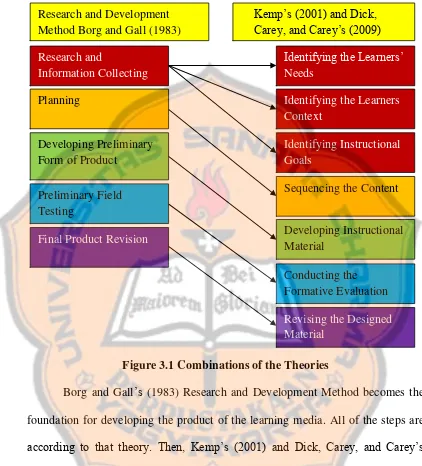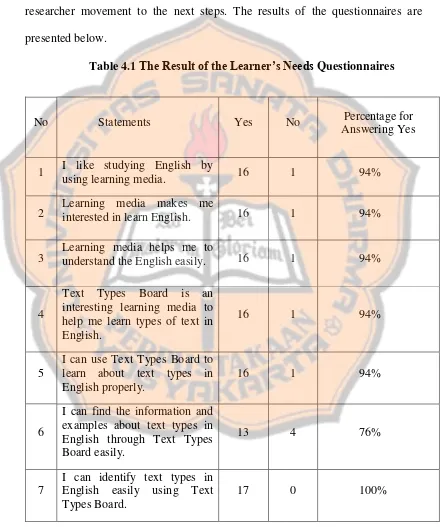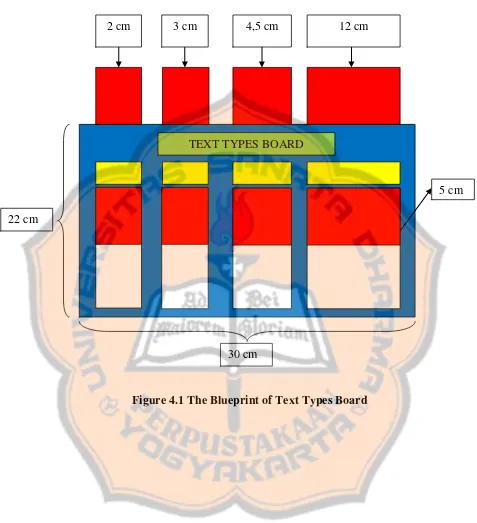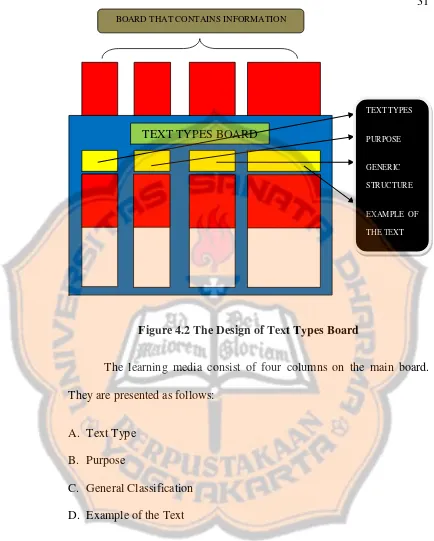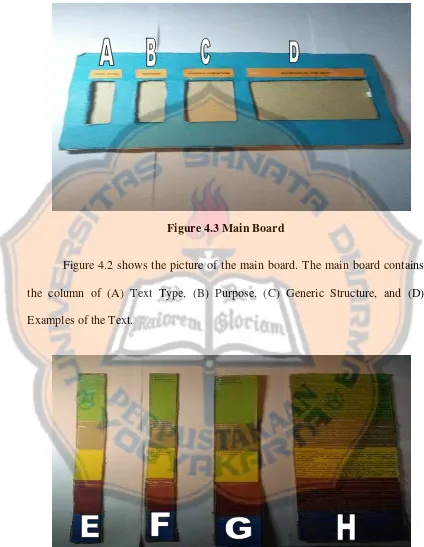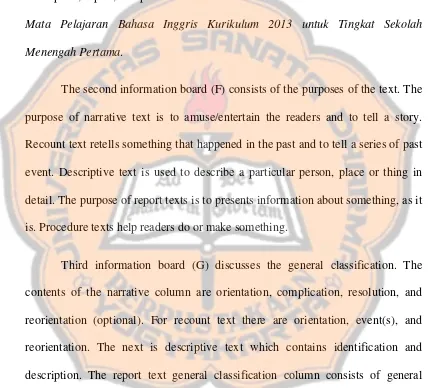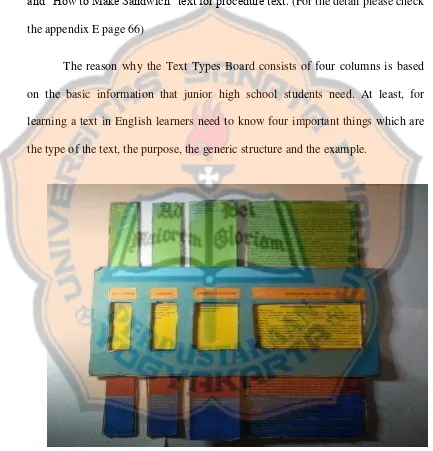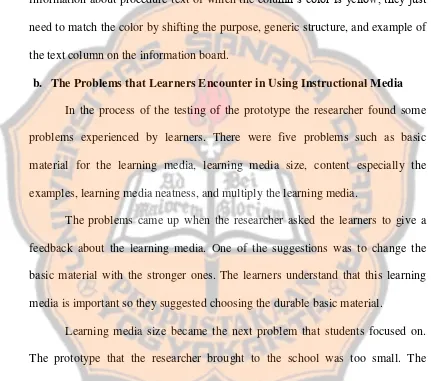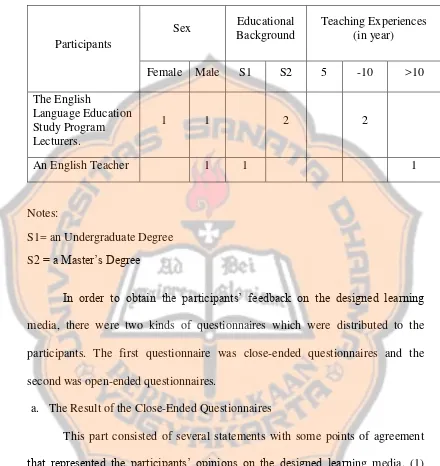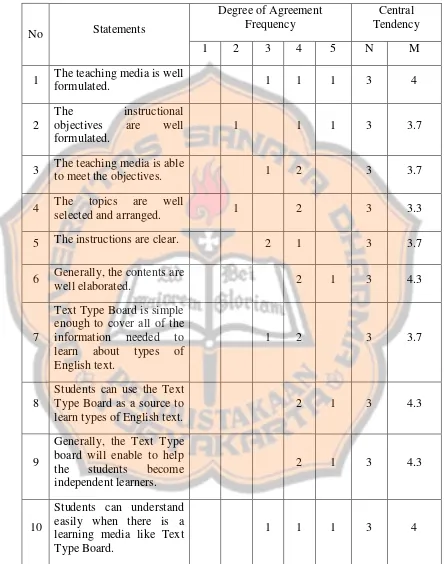THE USE OF TEXT-TYPES-BOARD FOR 7TH AND 8TH GRADES OF SMP PUTRA TAMA BANTUL
A SARJANA PENDIDIKAN THESIS
Presented as Partial Fufillment of the Requirements to Obtain the Sarjana Pendidikan Degree
in English Language Education
By
Victory Cahya Adi Student Number: 131214039
ENGLISH LANGUAGE EDUCATION STUDY PROGRAM DEPARTMENT OF LANGUAGE AND ARTS EDUCATION FACULTY OF TEACHERS TRAINING AND EDUCATION
SANATA DHARMA UNIVERSITY YOGYAKARTA
i
THE USE OF TEXT-TYPES-BOARD FOR 7TH AND 8TH GRADES OF SMP PUTRA TAMA BANTUL
A SARJANA PENDIDIKAN THESIS
Presented as Partial Fufillment of the Requirements to Obtain the Sarjana Pendidikan Degree
in English Language Education
By
Victory Cahya Adi Student Number: 131214039
ENGLISH LANGUAGE EDUCATION STUDY PROGRAM DEPARTMENT OF LANGUAGE AND ARTS EDUCATION FACULTY OF TEACHERS TRAINING AND EDUCATION
SANATA DHARMA UNIVERSITY YOGYAKARTA
vi ABSTRACT
Adi, Victory Cahya. (2017). The Use of Text-Types-Board for 7th and 8th Grades of SMP Putra Tama Bantul. Yogyakarta: English Language Education Study Program, Department of Language and Art Education, Faculty of Teachers Training and Education, Sanata Dharma University.
This study was intended to create a set of text type board for junior high school students. The learning media aim to help the students find some basic information about text types in English in a simple way. This learning media also help the students find proper sources of information directly.
This study was conducted to answer two research questions. The first question dealt with how a set of text type board learning media for junior high school is designed. The second question dealt with how the text type board teaching media affect the junior high school students’ learning process.
In order to answer the first research question, the writer adapted the seven steps of instructional model from Kemp (2001) and Dick, Carey and Carey’s (2009). The steps are identifying the needs of the learners, identifying the learners and context, identifying the instructional goals, sequencing the content, developing the instructional materials, conducting the formative evaluation, and revising the instructional materials.
vii ABSTRAK
Adi, Victory Cahya. (2017). The use of text-types-board for 7th and 8th grades of SMP Putra Tama Bantul. Yogyakarta: Program Studi Pendidikan Bahasa Inggris, Jurusan Pendidikan Bahasa dan Seni, Fakultas Keguruan dan Ilmu Pendidikan, Universitas Sanata Dharma.
Penelitian ini dimaksudkan untuk membuat seperangkat media pembelajaran bernama papan jenis teks untuk siswa SMP. Media pembelajaran ini bertujuan untuk membantu siswa dalam menemukan informasi jenis teks dalam Bahasa Inggris secara mudah. Media pembelajaran ini juga membantu siswa dalam menemukan informasi yang sesuai secara langsung.
Penelitian ini dilaksanakan untuk menjawab dua rumusan masalah. Rumusan masalah pertama berkaitan dengan bagaimana papan jenis teks untuk siswa SMP didesain. Rumusan masalah kedua berkaitan dengan pengaruh yang didapatkan setelah penggunaan media pembelajaran tersebut terhadap siswa SMP dalam proses pembelajaran mereka.
Untuk menjawab rumusan masalah pertama, penulis mengadaptasi teori tujuh langkah desain pembelajaran milik Kemp (2001) dan Dick, Carey dan Carey (2009). Langkah-langkah tersebut adalah mengidentifikasi kebutuhan siswa, mengidentifikasi konteks siswa, mengidentifikasi tujuan pembelajaran, mengurutkan konten, membuat materi pembelajaran, melaksanakan evaluasi formatif, dan memperbaiki materi pembelajaran.
Untuk menjawab rumusan masalah kedua, penulis menampilkan media pembelajaran yang disebut papan jenis teks. Kemudian, penulis melakukan pengujian alat di kelas 7 dan 8 SMP Putra Tama sebanyak empat kali pada tanggal 29 dan 30 Maret 2017 serta 5 dan 6 April 2017. Penulis juga melakukan validasi alat kepada validator untuk memastikan apakah media pembelajaran ini dapat digunakan atau tidak.
Hasil dari pengujian memunjukkan bahawa media pembelajaran yang ada dapat digunakan sebagai media pembeajaran (3,90) untuk siswa sekolah menengah pertama. Para siswa menyatakan bahwa dengan adanya media pembelajaran berupa papan jenis text dapat membantu mereka menyelesaikan permasalahan terkait teks dalam Bahasa Inggris.
viii
ACKNOWLEDGMENTS
First of all, I dedicate my biggest gratitude to Jesus Christ for all blessings
that are given to me so that I could struggle to finish my thesis. I would also thank
Him for giving me many beloved people who have supported me in doing my
thesis.
I would like to express my gratitude to my beloved parents, Sukartono and
Fajar Sih Wilujeng who become my motivations and reasons for finishing my
thesis. I also want to thank my brother Angger Ray Asa Gusti and all my family
members who have supported me in their own ways.
I also want to deliver my special gratitude to my thesis advisor Christina
Lhaksmita Anandari, S.Pd., Ed.M. I would not be able to do my thesis alone
without her kindness and patience in guiding me. I would also like to express my
deepest gratitude to my inspiring academic advisor, Drs. Y. B. Gunawan, M. A.
and all of the lecturers who have supported and guided me for about four years.
I would like to thank the family of SMP Putra Tama for their willingness
to become my inspiration to write this thesis. I would like to thank the
headmaster, Yusup Bambang Agung Saputro, M.Pd., the 7th and 8th English
teacher of SMP Putra Tama, FX August Tri, S.Pd, and all of the 7th and 8th
students of SMP Putra Tama.
I would like to thank all my friends in the English Language Education
Study Program batch 2013. I would like to thank all my classmates in class B for
their support for each other. I thank them for all memories and moments that we
ix
I would like to express my gratitude to the members of Radio Masdha FM
especially those from the batches 2012, 2013, 2014. Radio Smart FM and Radio
Sonora FM Yogyakarta. I thank them for always supporting me.
Last but not least I would like to thank all those who have supported me
and prayed for me during my study in Sanata Dharma University. May God bless
them.
x
TABLE OF CONTENTS
Page
TITLE PAGE ... i
APPROVAL PAGES ... ii
STATEMENT OF WORK’S ORGINALITY ... iv
PERNYATAAN PERSETUJUAN PUBLIKASI ... v
ABSTRACT ... vi
ABSTRAK ... vii
ACKNOWLEDGMENTS ... viii
TABLE OF CONTENTS ... x
LIST OF TABLES ... xiii
LIST OF FIGURES ... xiv
LIST OF APPENDICES ... xv
CHAPTER I INTRODUCTION A. Research Background ... 1
B. Research Questions ... 3
C. Research Significance ... 3
D. Definition of Terms ... 4
CHAPTER II REVIEW OF RELATED LITERATURE A. Theoretical Description ... 7
xi
2. Review on Related Theories ... 8
a. Learning Media... 8
b. Perception ... 9
c. The Young Adolescent Learner ... 9
d. Self-regulation Theory ... 10
e. Text Types of Reading and Writing ... 11
f. Teaching Reading and Writing Technique ... 11
g. Motivation ... 14
B. Theoretical Framework ... 14
CHAPTER III RESEARCH METHODOLOGY A. Research Method ... 16
B. Research Setting ... 18
C. Research Participants ... 18
D. Instruments and Data Gathering Technique ... 19
E. Data Analysis Technique ... 20
CHAPTER IV RESEARCH RESULTS AND DISCUSSION A. The Elaboration of the Steps in Designing and Making Text-types-board ... 23
1. Identifying the Learners’ Needs ... 23
2. Identifying the Learner and Context ... 26
xii
4. Sequencing the Content ... 27
5. Developing Instructional Materials ... 27
6. Conducting the Formative Evaluation ... 36
7. Revising the Designed Material ... 40
B. The Effect of Text-types-board for the Learners... 41
CHAPTER V CONCLUSIONS AND RECOMMENDATIONS A. Conclusions ... 44
B. Recommendations ... 46
REFERENCES ... 48
xiii
LIST OF TABLES
Table Page
4.1 The Result of the Learner’s Needs Questionnaires ... 24 4.2 The Description of the Participants in Formative Evaluation ... 37
xiv
LIST OF FIGURES
Figure Page
3.1 Combination of the Theories ... 17
4.1 The Blueprint of Text Types Board ... 30
4.2 The Design of Text Types Board... 31
4.3 Main Board ... 32
4.4 Information Board ... 32
xv
LIST OF APPENDICES
Page
Appendix A Letter of Research Permission ... 52
Appendix B Questionnaire for Learner’s Need Analysis ... 53
Appendix C Questionnaire for Formative Evaluation ... 57
Appendix D The Result of the Posttest ... 62
1 CHAPTER I INTRODUCTION
In chapter one, the researcher presents the introduction of this research.
There are four sections included in this chapter. They are research background,
research questions, significance of the study, and definiton of terms.
A. Research Background
One of the parts of learning language is talking about texts. English itself
is known to have texts that will also be studied in the first stage of formal
education. Junior high schools in Indonesia become the first level which has
English as a compulsory subjectafter the Department of Education decided to
remove English from elementary school and make it into local values (muatan
lokal).
Starting in 2013, Indonesian schools began using Kurikulum 2013
(Curriculum 2013) which emphasizes on independent learning. The teacher as the
facilitator must facilitate students with proper sources of learning. It aims to
prevent students from obtaining incorrect information and using incorrect sources
of learning. One of the sources of knowledge is learning media. Therefore,
learning media is very important as a source of information.
SMP Putra Tama is one of the junior high schools that meets the criteria of
2
one is the school has minimum facilities to support independent learning for
students.
SMP Putra Tama is located on Jalan Mgr. Alb. Sugiyopranoto number 02
Klodran, Bantul, Yogyakarta. The school has three classes for each grade from 7,
8, and 9 grades. There are five students in grade 7 and 16 students in grade 8. FX
August Tri, S.Pd is the teacher for both classes. According to the interview with
FX August Tri, S.Pd the English teacher of SMP Putra Tama the level of the
students’ English proficiency is elementary. The students need lots of improvement to increase their ability.
Teaching and learning activities for English subject in SMP Putra Tama
are based on Kurikulum 2013. It means the school applies student-centered
learning. However, the activities inside the classroom are still teacher centered
sometimes.
When the researcher asked the students about English learning so far, they
answered that the learning activities are sometimes boring because they just sit
and listen to the explanations from the teacher. The teacher also rarely use
learning media while explained about English topics. They hope that learning
English become interesting by using new methods and learning media.
Learning media become the researcher’s concern to help the SMP Putra Tama students get their English learning motivation. According to Van Els,
3
which may be used by teachers and learners to attain certain educational
objectives.
One of the parts of learning language is talking about texts. Therefore, the
researcher chose English topic about texts in 7th and 8th grades. The Text Types
Board is implemented as a learning media to help the students. The learning
media is specified only for help on written activity.
B. Research Questions
The researcher formulates two questions in this study:
1. How is a set of Text Types Board learning media for junior high school
designed?
2. How do the Text Types Board learning media affect junior high school
students learning process?
C. Research Significance
This study is expected to be beneficial for:
1. English Teachers
The researcher hopes this research can help the English teachers who are
going to teach Text Type in English for junior high school. The English teachers
may use the Text Types Board to help the students find the information about text
4
2. Future Researchers
The researcher hopes that this research can be used by future researchers
who wish to elaborate this topic deeper. The researcher also hopes this research
can be used as a reference to support some relevant studies in the future.
D. Definition of Terms
This section presents several keywords which are used in this study. This
section also presents the definitions of several terms dealing with what the
researcher discussed in this study.
1. English Text Types
According to Rotter and Bendl (1998) there are twelve text types in
English. They are narrative, recount, descriptive, report, explanation, analytical
exposition, hortatory exposition, procedure, discussion, review, anecdote spoof,
news item. In this study the researcher only used narrative, recount, descriptive,
report, and procedure text for junior high school due to 2013 curriculum.
2. Junior High School
According to UU RI No. 20 Tahun 2003, education path are devided into
three levels as follows primary education, middle education, and higher education.
Junior High School, known locally as Sekolah Menengah Pertama or abbreviated
5
3. Learning media
According to Van Els et al (1984), learning media are all aids which may
be used by teachers and learners to attain certain educational objectives.
Furthermore, media can be specified in different ways. In this study, learning
media refer to Text Types Board which is in a form of board. In this learning
media contain Text Type, Purpose(s), General Classification, and Example of the
Text.
4. Perception
According to Kotler (1995) Perception is the process of how people select,
organize, and interpret information inputs to create a meaningful overall picture.
In this study theory of perception is needed to design a learning media. All of the
development process is based on learners’ perceptions/needs. 5. Independent Learning
According to Foster (1972), Independent study is a process, a method and
a philosophy of education: in which a student acquires knowledge by his or her
own efforts and develops the ability for inquiry and critical evaluation. In this
study, the functions of the Text Types Board are as source of knowledge and
comparison. These two aspects lead the learners into an independent learning.
6. Self-regulation
According to Bandura (1991), self-regulation theory is a system of
conscious personal management that involves the process of guiding one's own
6
contributors to their own motivation, behavior, and development within a network
of reciprocally interacting influences. In this study, learners can use Text Types
Board according to their needs. They know whenever they need information about
a text they could use this learning media. The application is easy and simple in a
7
CHAPTER II
REVIEW OF RELATED LITERATURE
This chapter reviews the theories that underline the study. It consists of
two parts, namely theoretical description and theoretical framework. Theoretical
description discusses about the theories used by the researcher as the bases of the
study. Theoretical framework explains how the theories help the researcher to
answer the research questions.
A. Theoretical Description
This part consists of related studies and review of related literature.
Related studies part contains of the previous studies that related to the research
that conducted. In review on related theories section, the researcher provides
review on related theories for supporting the research.
1. Related Studies
In order to avoid unnecessarily replication, the researcher previews some
studies which are related to this study. Aini (2013) with her research aimed to
investigate (1) the use of instructional media by the teachers in teaching English to
young learners; (2) the problems that they encounter in using instructional media;
also (3) problem solving of the media utilization problems has done the analysis
8
Then, Damayanti (2012) describes the performance and the weaknesses of
the English learning media and applied it at SMP Negeri 8 Palopo. She found that
the performance of her media have weaknesses such as the content, grammar, and
the form of her learning media.
Text Types Board appears to answer the problems through the product of
learning media which is acceptable for young adolescence learners. The previous
studies also become the researcher’s consideration especially for the quality of the learning media. The content, the grammar, and the form will be designed clearly
and carefully.
2. Review on Related Theories
In this section, the researcher provides review on related theories for
supporting the research. The theories are:
a. Learning media
Learning media is valuable instructional tools that can help learner make
learning more effective and interesting. Harmer (2007) says that a range of
objects, pictures and other things that can be used as instructional media to present
and manipulate language and to involve students in the activities. Popular print
media offer good opportunities for improving learners reading and writing skills
in particular (Bertram, 2010).
To develop the learning media the seven steps from Kemp and Dick,
Carey and Carey’s (2009) instructional model become the researcher’s reference. They are identifying the needs of learner, identifying the learner and context,
9
instructional materials, conducting the formative evaluation, revising the
instructional materials.
Reiser and Dick (1996) designate instructional media as one of the
instructional planning that should be prepared by teachers before coming in
classroom. Instructional media can be defined as the physical means including
traditional means such as chalk, blackboard, textbooks and modern means such as
videos, tape, recorders, computers, overhead projectors, and others presenting
instructional activities delivered to the students.
Thus it can be concluded that instructional media are everything
connecting and delivering messages purposively from teachers to students in order
to bring in controlled instructional environment.
b. Perception
According to Kotler (1995), perception is the process of how people select,
organize, and interpret information inputs to create a meaningful overall picture.
In this study perception is needed to form a learning media especially from
learners’ perceptions.
Theory of perception is important for this research because the product of
the research is designed for the students so all of the components, contents, and
form are based on the students’ perceptions and needs. c. Young Adolescent Learners
According to Wilson and Horch (2002), developmental characteristics of
10
social, and emotional. All four areas are important because they directly influence
what happens in the classroom. Let be focused on the intellectual characteristics.
On the intellectual characteristics, the first thing that young adolescent
learners have is active involvement in learning. Then, they are motivated to learn
when the lessons are taking their attention. They also exhibits, independent and
have a critical thinking.
Theory of the young adolescent learners is needed by the researcher to
develop the learning media according to their characters. Junior high school
students are included in young adolescent learners. Thus, based on the subject of
the research the researcher needs this theory to develop the learning media that
suitable for their characteristics.
d. Self-regulation Theory (SRT)
According to Bandura (1991), self-regulation theory is a system of
conscious personal management that involves the process of guiding one's own
thoughts, behaviors, and feelings to reach goals. Self-regulation consists of several
stages, and individuals must function as contributors to their own motivation,
behavior, and development within a network of reciprocally interacting
influences.
Expanding beyond Bandura's three steps, Redmond (2012) reviews how
specific strategies enhance individual learning processes and how it orients toward
regulation and achievement processes including: observation,
self-evaluation, self-reaction, and self-efficacy. Self-observation may be considered
11
efficacy. The researcher needs these theories to make sure that learners can use
Text Types Board according to their needs. That activity indicates self-regulation.
e. Text Types of Reading and Writing
According to Rotter and Bendl (1998), there are narrative, recount,
descriptive, report, explanation, analytical exposition, hortatory exposition,
procedure, discussion, review, anecdote spoof, news item. In this study, according
to Kurikulum 2013, text types that would be learned by junior high school
students are only narrative, recount, descriptive, report, and procedure text.
Based on Rotter and Bendl (1998), narrative’s social function is to tell stories or past events and entertain the readers. The generic structure of the text is
orientation, complication, and resolution. Recount text is a text which retells
events or experiences in the past. Its purpose is either to inform or to entertain the
readers. The generic structure is orientation, events, and reorientation.
Rotter and Bendl (1998) also stated that descriptive text is texts which
function to describe a particular person, place, or thing. The generic structure is
identification and description. Report text is a text which presents information
about something as it is. It is as a result of systematic observation analysis. The
generic structure is general classification and description. Procedure is a text that
is designed to describe how something is achieved through the sequence of
actions or steps.
f. Teaching Reading and Writing Technique
When teachers deliver the text types material, they have to use the reading
12
the teaching reading techniques, teachers should be pay attention to several
elements.
The first one is focused on the reading process. To accomplish this goal,
instructors focus on the process of reading rather than on its product. When
students read the text types the reading process takes an important role especially
for identifying the type of the text.
Second, the instruction in reading strategies is not an add-on, but rather an
integral part of the use of reading activities in the language classroom. The
challenges emerge here because teacher should be able to help their students
become effective readers by teaching them how to use strategies before, during,
and after reading.
Third, reading activity for students should be able to stimulate their
communicative competence through classroom and homework reading activities.
This step becomes the next challenge for teachers because they have to resemble
(or be) real-life reading tasks that involve meaningful communication using
English text types.
Learning English text types is not only talk about reading but also
producing written text related to English text types. According to Verner (2009)
there are several techniques that teachers may use for teaching English text types. The first one is brainstorming. The object in brainstorming is to compile as
large a list as possible of potential examples for a given topic. The challenge for
teacher is how to stimulate their idea by providing several examples of English
13
Then, the next step is free writing. Free writing is an individual activity for
getting thoughts from students’ head on to paper. How to explain the concept of stream of consciousness and tell students that free writing is easy become the
challenge that teachers must be face. Next, the important part is journalistic
questions. Teachers should be able to explain journalistic questions by reviewing
the question words: who, what, where, when, why and how.
The last one is cluster mapping. It shows relationships between ideas.
English teachers must be able to facilitate the students in this part because cluster
mapping does not only talking about teacher’s teaching abilities to explain about this concept but also the students must also be able to identify whether their
written products are related and well-structured or not. Teacher must have at least
examples of English text types which are clear and well-structured.
To make the learning media the researcher needs these theories to make
sure that the media contains those techniques. They are also required to make sure
that the learning media is proper enough to be a source of knowledge.
The use of Text Types Board for both teaching reading and writing
techniques is as a first source of knowledge and as a reference for students. Text
Types Board as a first source of knowledge means when students need a source of
knowledge for the first time, Text Types Board can facilitate them in learning
types of text in English.
Text Types Board as a reference of learning means this learning media can
also stimulate their independent learning. They can use Text Types Board as a
14
g. Motivation
According to Nevid (2013) motivation is defined as the process that
initiates, guides, and maintains goal-oriented behaviors. Motivation is what causes
human to act, whether it is getting a glass of water to reduce thirst or reading a
book to gain knowledge. Theory of motivation is important for the researcher
because one of the purposes of the research is to increase students’ interest in learning text types in English. Through this theory, the researcher wants to make
the learning media interesting, so it can increase the students’ motivation to learn English.
B. Theoretical Framework
According to Kurikulum 2013, types of text that would be learned by
junior high school students are narrative, recount, descriptive, report, and
procedure text.
This study dealt with designing a set of Text type Board. This learning
media can help the students get the information about text typesin English. To
conduct this research, the researcher needed several theories to solve the research
problems. The first one is theory of young adolescent by Wilson and Horch
(2002). The researcher paid attention to some factors affecting the students’ understanding about text types. Since students in junior high school are young
adolescents, teachers have to know about developmental characteristics of young
adolescents that have been grouped into four categories: physical, intellectual,
15
researcher answer the first research question, especially on the object of the
research which is junior high school.
After knowing the characteristics of the object, the researcher also paid
attention to the techniques for teaching reading and writing in text type topic.
Based on www.nclrc.org and Verner (2009), there are several techniques in
teaching reading and writing. Reading techniques focuses on the reading process,
integrating reading strategies, and using authentic materials and approaches. The
writing techniques there are brainstorming, free writing, and cluster maping. The
researcher needed those theories to answer the second research question especially
for the quality of the media as a support in teaching text types material. The
theories were also necessary to make sure that the learning media is proper to be a
source of knowledge.
Also talked about the media’s effect for the students. The researcher needed the theory of motivation by Nevid to implement the effect as a motivation.
According to Nevid (2013) motivation is defined as the process that initiates,
guides, and maintains goal-oriented behaviors. Motivation is what causes us to
act. Hence, this theory was needed to help researcher answer the second research
question.
Then, to get a good quality of the learning media, the researcher used
questionnaire as a source of the data to develop the Text Types Board. The
16 CHAPTER III
RESEARCH METHODOLOGY
In this chapter the researcher presents the methodology to answer the
research questions. This chapter covers research method, setting, participants, data
gathering technique and data analysis.
A. Research Method
To answer the research questions, the researcher used Research and
Development method by Borg and Gall (1983). There are five steps in R & D: 1)
Research and Information Collecting: It includes review of literature, classroom
observations, and preparation of report of state of the art; 2) Planning: Planning
includes defining skills, stating objectives determining course sequence, and small
scale feasibility testing; 3) Develop Preliminary Form of Product: It includes
preparation of instructional materials, handbooks, and evaluating devices; 4)
Preliminary Field Testing: This step includes testing the product into the real
target or subject in a real condition; 5) Final Product Revision: Final product
revision includes validation and final revision. The combination between Borg
17
Figure 3.1 Combinations of the Theories
Borg and Gall’s (1983) Research and Development Method becomes the foundation for developing the product of the learning media. All of the steps are
according to that theory. Then, Kemp’s (2001) and Dick, Carey, and Carey’s
(2009) instructional model help the researcher understand the steps in Borg and
Gall’s method in detail. For example the first step in Borg and Gall’s research and development method is research and information collecting. Based on that step,
18
which steps are clearer such as identifying the learners’ needs, identifying the learner and context, and identifying instructional goals. Furthermore, both of the
theories strengthened each other.
B. Research Setting
The research was conducted in the 7th and 8th grades of SMP Putra Tama
Bantul, Daerah Istimewa Yogyakarta. The researcher has already observed that
the teaching media was proper to support the learning activity there. According to
the condition, the school has limited facilities to support the learning activities.
There are no supporting learning media besides the main learning media like
internet access, projectors, viewers, and whiteboards. Then, the researcher
conducted the research on March 29th, 30th and April 5th, 6th 2017 to 7th and 8th
grades of SMP Putra Tama.
C. Research Participants
The 17 participants in this research were divided into two groups. The first
group was the participants in Research and Information Collecting and the second
one was the participants in the Preliminary Field Testing. The participants in the
Research and Information Collecting were the English teacher in SMP Putra Tama
and all students of the 7th and 8th grades of SMP Putra Tama. Preliminary Field
Testing participants were English teacher who became the evaluatorand examiner
for the Preliminary Field Testing. The research was conducted on March 29th, 30th
19
D. Instruments and Data Gathering Technique 1. Research Instrument
The researcher used questionnaire and interview for the instruments.
According to Creswell (2012), a questionnaire is a form used to collect the data
from participants in a study to complete and return to the researcher. Then,
Creswell (2012) defines an interview as one of the instruments that the researcher
asked some questions based on an interview guide, listened to the answers,
observed the behavior, and recorded the responses.
For research and information collecting data step, the researcher also used
interview technique. This technique was applied to know the condition of the
learning process in SMP Putra Tama. The interview was conducted for English
teacher in SMP Putra Tama and 17 students of the 7th and 8th grades of SMP Putra
Tama Bantul. For Preliminary Field Testing the researcher used questionnaires for
English teacher who became the evaluatorand examiner for the Preliminary Field
Testing.
2. Data Gathering Technique
The data were gathered from questionnaire and interview. The
questionnaire was a research instrument which could accommodate the researcher
in collecting many data. The results of collected data could also be measured
easily in the form of tables if the researcher used questionnaire as the instrument.
20
researcher form number of questions and distribute them to the respondents. The
researcher uses this theory for collecting the data as a source for the research.
Besides, the data is also used as a reference to develop the learning media. All of
the data from Research and Information step in interview technique would be
analyzed. The interview was conducted for an English teacher in SMP Putra Tama
and all students of the 7th and 8th grades of SMP Putra Tama. For Preliminary
Field Testing the researcher used questionnaires for English teacher who became
the evaluator and examiner for the Preliminary Field Testing.
E. Data Analysis Technique
The data were gathered from the questionnaire and the interview. The
analysis was conducted by collecting all the data from questionnaires which were
spread to the 17 students of 7th and 8th grades of SMP Putra Tama.
In this study, there were two kinds of data. The first was the data from the
learners’ needs analysis questionnaire. The questionnaire contained ten closed-ended questions. All of the questions consisted of two choices “yes” or “no”. To analyze the closed-ended questions, the researcher calculated the mean of each
answer for each number to know the average condition. The formula is:
Note:
n = the number of the participants who choose for certain option = the total number of participants
21
Then, researcher need to test the reliability and validity of the learning
media. Reliability and validity were essential to the effectiveness of any
data-gathering procedure according to Best and Khan (2006). This research needed
multiple data to answer the research questions.
The study was conducted to know the quality of the learning media.
The quality of learning media tested by validators. The validators’ perception should be identified to fulfill the reliability and validity of research, so
multiple data is needed in this research.
The formative evaluation questionnaires consisted of ten closed ended
questions and an open-ended question. There are five points of agreement in
the close-ended questions namely (1) very poor, (2) poor, (3) undecided, (4)
good, and (5) very good. The researcher calculated the mean of each option
for each number. The formula is:
Note:
M = Mean or average
= the sum of respondent’s answer
22
The results of open-ended question were the general comments,
suggestions, and opinion for improvement about the learning media. The
23 CHAPTER IV
RESEARCH RESULTS AND DISCUSSION
This chapter presents the results of the research through the answer of the
research questions. There are two parts in this chapter. The first part is divided
into two parts which arethe elaboration of the steps in designing and making Text
Types Board and the description of the Text Types Board model. The first part
aims to answer the first research question about how a set of Text Types Board
learning media for junior high school is designed. The second part is the
elaboration about the effects of using Text Types Board for students’ learning process. The second part aims to answer the second research question on how do
the Text Types Board affect the learning process in junior high school process.
A. The Elaboration of the Steps in Designing and Making Text Types Board The researcher combined Kemp’s (2001) and Dick, Carey, and Carey’s (2009) instructional design model in the research method. The following is the
explanation of the Kemp’s and Dick, Carey, and Carey’s seven steps used in this study.
1. Identifying the Learners’ Needs
In this step, the researcher distributed seventeen questionnaires to grade 7th
and 8th of SMP Putra Tama students. The questionnaires consisted of ten
24
needs. The questions were written in Indonesian in order to make the questions
understandable for the respondents.The questionnaire only provided yes or no
answer because the researcher needed absolute answers to determine the
researcher movement to the next steps. The results of the questionnaires are
presented below.
Table 4.1 The Result of the Learner’s Needs Questionnaires
25 types in English by using Text Types Board.
16 1 94%
Based on the result of the questionnaire already distributed, learning text
types in English by using learning media was important for the students’ learning process. Focusing on the questions number one until three, the first question
indicated that the existence of learning media can increase their learning interest.
The result was 94% of the respondents chose “yes” as the answer to the first
26
From the results of the questionnaires, the researcher concluded that the
students needed to have a learning media to help them on their learning process.
The learning media was expected increase their interest for learning English text
types in English.
2. Identifying the Learner and Context
After identifying learners’ need, the next step was identifying the learner and context. The researcher conducted pretest for the students of 7th and 8th grades
of SMP Putra Tama to know the characteristic and the knowledge that the learners
had. The pretest examined the common knowledge about text types in English
such as narrative, descriptive, report, procedure, and recount text. The researcher
conducted the pretest by asking the students of 7th and 8th grades of SMP Putra
Tama about the purposes of the several texts to know their knowledge. The result
was not good because not all of the students knew the purposes of the texts asked
in the pretest. The students also found the difficulties to find sources to answer
questions in the pretest because of the limited school facilities.
3. Identifying Instructional Goals
In this step, the researcher paid attention to the knowledge that the 7th and
8th grades of SMP Putra Tama’s students had and to the learners’ need. The result of the analysis was the 7th and 8th grades students of SMP Putra Tama hadknown
about several texts. However, the students still found some difficulties to mention
the purposes of the texts and find the sources to answer the pretest questions.
After knowing the problems and the knowledge of the students, the
27
understand about text types in English. The researcher included all of the basic
knowledge about text types in English such as type of text, the purpose of the text,
the generic structure, and the example of the text. The instructional goals were
specified into how to use the learning media.
4. Sequencing the Content
After identifying the instructional goals, the researcher sequenced the
content of the designed learning media. From the needs analysis, the researcher
found several problems of the students when they learnt about text types in
English. The first problem was the students often answered incorrect when
mentioning the text types according the purposes of the text. Second, students
were not able to mention the generic structure of the texts. Third, students
sometimes mentioned the example of the text types in English falsely. From that
kind of problems, the researcher planned to make the simplest learning media that
cover all of the contents related to the problems. The content included four
columns which was type of text, the purpose of the text, the generic structure, and
the example of the text.
5. Developing Instructional Materials
This section also aims to answer the first question in the research question:
How is set of Text Type Board learning media for junior high school designed?
The researcher developed the instructional materials by using the reference from
Aini (2013) who states that instructional media aim to investigate (1) the use of
28
using instructional media; also (3) problem solving of the media utilization
problems.
The researcher considered those three purposes when developing the
instructional media. Here the elaboration of the three purposes helped the
researcher test the reliability of the learning media called Text Types Board:
a. The Use of Instructional Media to Young Learners
This learning media was designed for young learners. According to
Wilson and Horch (2002), developmental characteristics of young adolescents
have been grouped into four categories: physical, intellectual, social, and
emotional. All four areas are important because they directly impact what happen
in the classroom. No area should take priority over the others and all areas must
be addressed. This learning media also considered those four kind of
developmental characteristics.
Text Types Board indirectly asks the learners to do the physical
movements by shifting the board and seeking information about text that learners
needed. This part represents fulfillment of the need for physical activity.
Text Types board as a source of information also supports the need for
young adolescence learners especially on the intellectual side. This learning media
gives valid and simple contents of text types information. Hence, it can quickly
improve intellectual ability of young adolescence learners.
The next point of developmental characteristics for young adolescence
learners is social aspect. In the future, this learning media can be used in a class
29
focus group discussion to identify several texts’ elements such as the text type, the purpose of the text, and general classification through the use of Text Types
Board.
The emotional aspect becomes the fourth point of developmental
characteristics. The researcher deliberately chose the use of color to give an
interesting impression while developed this learning media. Children's emotions
are directly related to their mood, attraction, and interest. Therefore, the
development of Text Types Board also paid attention to interesting color
combinations to be seen.
The process of making the learning media start from considering the
component of the learning media. The researcher chose carton paper because the
component is strong enough. Then, the researcher cut the carton by following the
30
Figure 4.1 The Blueprint of Text Types Board TEXT TYPES BOARD
22 cm
30 cm
2 cm 3 cm 4,5 cm 12 cm
31
Figure 4.2 The Design of Text Types Board
The learning media consist of four columns on the main board.
They are presented as follows:
A. Text Type
B. Purpose
C. General Classification
D. Example of the Text
TEXT TYPES BOARD
TEXT TYPES
PURPOSE
GENERIC
STRUCTURE
EXAMPLE OF
THE TEXT
32
Figure 4.3 Main Board
Figure 4.2 shows the picture of the main board. The main board contains
the column of (A) Text Type, (B) Purpose, (C) Generic Structure, and (D)
Examples of the Text.
33
Figure 4.3 shows the picture of the second board that contains all of the
information about (E) text type, (F) purpose, (G) generic structure, and (H)
examples of the text. The first information board (E) consists of the text types
needed for junior high school learning material. They arenarrative, recount,
descriptive, report, and procedure text. All of those texts were taken from Silabus
Mata Pelajaran Bahasa Inggris Kurikulum 2013 untuk Tingkat Sekolah
Menengah Pertama.
The second information board (F) consists of the purposes of the text. The
purpose of narrative text is to amuse/entertain the readers and to tell a story.
Recount text retells something that happened in the past and to tell a series of past
event. Descriptive text is used to describe a particular person, place or thing in
detail. The purpose of report texts is to presents information about something, as it
is. Procedure texts help readers do or make something.
Third information board (G) discusses the general classification. The
contents of the narrative column are orientation, complication, resolution, and
reorientation (optional). For recount text there are orientation, event(s), and
reorientation. The next is descriptive text which contains identification and
description. The report text general classification column consists of general
classification and description. The last column is about the general classification
of procedure text. It consists of goal/aim, materials/equipment(s), and
34
The fourth information board (H) consists of examples of the text. “Snow
White” for narrative text, “My Adolescence” text for recount text, “Monas National Monument” for descriptive text, “The Pelican Report” for report text, and “How to Make Sandwich” text for procedure text. (For the detail please check the appendix E page 66)
The reason why the Text Types Board consists of four columns is based
on the basic information that junior high school students need. At least, for
learning a text in English learners need to know four important things which are
the type of the text, the purpose, the generic structure and the example.
35
Figure 4.4 shows the final form of Text Types Board after all of the parts
are combined. The Text Types Board size is 30 cm x 18 cm with the color
combination like figure 4.1 pages 29 to use this tool student should shift the
information board to find the same color. For example, when the students need
information about procedure text of which the column’s color is yellow, they just need to match the color by shifting the purpose, generic structure, and example of
the text column on the information board.
b. The Problems that Learners Encounter in Using Instructional Media In the process of the testing of the prototype the researcher found some
problems experienced by learners. There were five problems such as basic
material for the learning media, learning media size, content especially the
examples, learning media neatness, and multiply the learning media.
The problems came up when the researcher asked the learners to give a
feedback about the learning media. One of the suggestions was to change the
basic material with the stronger ones. The learners understand that this learning
media is important so they suggested choosing the durable basic material.
Learning media size became the next problem that students focused on.
The prototype that the researcher brought to the school was too small. The
learners suggested making it bigger so all of the learners in the classroom could
see it.
They also asked the researcher to give other examples. The learners were
very excited when they knew about Text Types Board. Thus, they want this
36
c. Problem Solving of the Media Utilization Problems
From the result of step number one and two, the researcher revised the
designed material based on the feedback, comments, and suggestions given by the
learners. This part helped the researcher understand about how the final Text
Types Board would look like. Paying attention into the theory from Wilson and
Horch (2002) about developmental characteristics of young adolescents such as
physical, intellectual, social, and emotional. In addition, the researcher also
considered the suggestions from all of the learners like basic material for the
learning media, learning media size, content especially the examples, learning
media neatness, and amount the learning media.
6. Conducting the Formative Evaluation
The next step is conducting the formative evaluation. The researcher
distributed the questionnaires to three participants; two of them are the lecturers of
the English Language Education Study Program of Sanata Dharma University and
the other is an English teacher. The evaluation was conducted to obtain the
feedback on the learning media. The result of the evaluation was used as the input
for improving the designed learning media. The description of the evaluators is
37
Table 4.2 The Description of the Participants in Formative Evaluation
Participants
participants. The first questionnaire was close-ended questionnaires and the
second was open-ended questionnaires.
a. The Result of the Close-Ended Questionnaires
This part consisted of several statements with some points of agreement
that represented the participants’ opinions on the designed learning media. (1) Indicated that the degree of agreement was very poor, (2) indicated poor, (3)
undecided, (4) good, and (5) the degree of agreement was very good. The results
38
Table 4.3 The Result of the Formative Evaluation
No Statements
6 Generally, the contents are
39
Notes:
N: Total Respondent/Data M: Mean
From the results of the close-ended questionnaires, it was found that the
grand mean is 3.90. It means that the Text Types Board is appropriate and suitable
to help the students learn text types in English. However, there were some aspects
that needed to be revised to make it better.
b. The Result of the Open-Ended Questionnaires
In this part the respondents were free to give suggestions, comments, and
opinions on the learning media. The questions in open-ended questionnaire are
asked the respondents to give the comments or opinions about Text Types Board.
From the results of the feedback the researcher found some good points. They are
as follows.
1. The idea was good.
2. The board was interesting with the colorful form.
3. The board was meaningful.
4. The learning media was simple.
5. The learning media could help the learners understand the material.
Thus, the researcher found out some points needed to be revised to make
the learning media better. They are as follows.
1) The Material
Two of the respondents advised the researcher to change the material of
the board into more durable one. They stated that the material needed to be
40
2) The Instructions
Two of the respondents suggested adding some instructions about how to
use the learning media. They also suggested adding the objective of using this
learning media.
3) The Grammar
Three of the respondent suggested that the researcher should check the
content of the learning media because there were some grammatical mistakes.
4) The Content
A respondent advised the researcher should add more examples to help the
learners understand the materials. Two respondents also suggested that the
researcher should vary the content to make them become more interesting for
learners especially themes of the text that are close to them.
7. Revising the Designed Material
From the result of the questionnaires, the researcher revised the designed
material based on the feedback, comments, and suggestions given by the
respondents. These are the results of the revision:
1) The researcher changed the looks of the learning media into a more colorful
one. Actually, the color is already available on the board but the evaluators
wanted it to be more colorful to make it interesting.
2) The researcher changed the material of the learning media into the stronger
41
3) The researcher changed the examples of the text into the complex one. Before
the revision, the examples were too simple. The validators considered that the
examples also contained more information.
4) The researcher rechecked the grammar inside the learning media and found
several mistakes.
5) The researcher made the instructions about how to use the Text Types Board
learning media because before the revision there was no instructions/manual
about how to use the learning media.
However the researcher did not add more examples because the researcher
thought that this is only a prototype that could be developed by other researchers.
The researcher would like to give a space for other researchers.
B. The Effect of Text Types Board for the Learners
This section aims to answer the research question number two in the
research questions on how the Text Type Board learning media affect junior high
school students learning process. The discussion about how far the availability of
Text Types Board helps the students. Then, could Text Types Boardstimulate the
students of 7th and 8th grades of SMP Putra Tama’s independent learning on the
learning process? From the result of the questionnaires that already distributed
(see table 4.1 p. 24), the researcher wanted to know about the effects to the
learners.
According to Wilson and Horch (2002), interesting things would make
young adolescence learners pay more attention to it. In this case, learning media
42
four indicated that 94% of the respondents agreed that Text Types Board was an
interesting learning media. Then statement number five, 94% of the respondent
understood how to use the learning media. That result indicated that this learning
media was easy to use. The researcher used the perception theory by Kotler
(1995) to make the learning media. This result also indicates that the learning
media was designed according to the students’ perception and needs.
Talking about the completeness of the content inside, Text Types Board
got 76% which means still need several revisions especially for the examples.
However, the learners could easily identify the texts using the Text Types Board’s help. The number of percentage was 100%. They could alsouse it individually or
in a group. While they used in a group 94% agreed that Text Types Board still
helps.
According to Bandura (1991) Self-regulation theory is a system of
conscious personal management that involves the process of guiding one's own
thoughts, behaviors, and feelings to reach goals.This learning media could
alsostimulate the learners’ self-regulated ability. By using this learning media, 82% of the respondents agreed that Text Types Board could increase their
independent learning. Their identification skill is also increased when Text Types
Board help them do the text types assignments because 94% of the respondents
agreed that their identification skill is increased.
All of the results of the questionnaire indicate that the availability of Text
43
is helpful for the students. They also became motivated to learn about text types in
English. According to Nevid (2013), motivation is defined as the process that
initiates, guides, and maintains goal-oriented behaviors. The number above 80%
from the questionnaire result also indicated that the motivation among the
44 CHAPTER V
CONCLUSIONS AND RECOMMENDATIONS
This chapter summarizes the major findings of the research and the
limitations. This chapter covers two parts: conclusions and recommendations. The
first part concludes all of the answers to the research questions. The second part
presents recommendations for junior high school English teachers and future
researchers who intend to develop and elaborate the Text Types Board learning
media.
A. Conclusions
This study was conducted to find out how a set of Text Types Board was
designed and how Text Types Board learning media affect junior high school
students’ learning process. Therefore, the first research problem dealt with the process of designing the learning media and the second research problem dealt
with the effects of Text Types Board for the student’s learning process.
The researcher combined Kemp’s (2001) and Dick, Carey, and Carey’s (2009) instructional design model to answer the first question. The following are
seven steps used in designing the learning media called Text Types Board.
1. Identifying the needs of the learner
2. Identifying the learner and context
45
4. Sequencing the content
5. Developing the instructional materials
6. Conducting the formative evaluation
7. Revising the instructional materials
In designing the Text Types Board, the researcher identified the learners’ needs by analyzing the questionnaires given to the learners. After identifying the
learners’ needs, the next step was identifying the learners’ needs and brought it into the context. Thus, the researcher gave them a test about the basic knowledge
about text types in English. The researcher asked them to mention the purposes
and the general classifications of several text types in English. From that activity,
the researcher knew their problem regarding text types in English.
After knowing the learners’ needs and the context, the researcher formulated the instructional goals. Then, the contents were sequenced based on
the materials that the learners needed to learn. The researcher did not include
other text types in English that was not thought for junior high school. Therefore,
the learning media will be useful for the learners.
In order to answer the second question stated in research problems, the
researcher presented a learning media called Text Types Board which consists of
four columns. The columns are as follows:
1. Text Types
2. Purpose
3. General Classification
46
The researcher wanted to know whether the Text Types Board functioned
well or not. The researcher gave some exercises about text types during the
students’ learning process. Then, the researcher provided the learning media in the classroom and asked the students to use the learning media if they needed it.
According to the questionnaire and the observation, the result was showed that the
learning media called Text Types Board was needed by the learners. They also
understood how to use it as a source of learning to help them finish the exercise.
The conclusion about this research is the researcher learns something
about the design. The combination of effort and goodwill become color of the
journey when designing this learning media. Both of them become the
researcher’s spirit to finish this research. Efforts never betray the result. This learning media has successfully given positive effect for the students.Students
said that the availability of the Text Types Board really helps them solve the
problem about English texts. The results of the questionnaire agree that high
percentage proves that Text Types Board is needed by students. This learning
media also got 3.90 when passing formative evaluation stage. It proves that Text
Types Board has ready to become a learning media for students especially in
junior high school.
B. Recommendations
This part provides recommendations for the junior high school English
teachers and other researchers who are interested in developing the learning media
47
1. The Junior High School English Teachers
The researcher recommends that the junior high school teachers implement
the Text Types Board and use it as the learning media to teach text types in
English. The researcher hopes that the teachers help the students by showing how
to use the Text Types Board. The researcher also recommends that Text Types
Board becomes one of the proper sources for the students when they need
information related with text types in English.
2. Other Researchers
The design of the learning media is very simple. The materials for making
the Text Types Board are also simple and cheap. The contents of the Text Types
Board are also limited especially for the examples of the texts. Therefore, the
researcher invites other researchers who are interested in learning media like Text
Types Board to continue the research by elaborating, developing, and
48 REFERENCES
Aini, W. N. (2013). Instructional media in teaching English to young learners: A case study in elementary schools in Kuningan. unpublished thesis, Universitas Pendidikan Indonesia.
Bandura, A. (1991). Social cognitive theory of self-regulation. Organizational Behavior and Human Decision Processess, 50, 248-287
Bertram, C., Ranby, P., Adendorff, M., Reed, Y., & Roberts, N. (2010). Using media in teaching. Cape Town: South African Institute for Distance Education.
Creswell, J. W. 2012. Educational research: Planning, conducting, and evaluating quantitative and qualitative research (4th Ed). Boston: Pearson Education, Inc.
Dick, W., Carey, L., & Carey, J. (2009). The systematic design of instruction. Upper Saddle River, NJ: Pearson Education Limited.
Harmer, J. (2007). The practice of language teaching. Cambridge: Ashford Color Press.
Kemp, J. (2001). Instructional design: A plan or unit and course development. New York: Wiley Inc.
Kotler, P. (1995). Marketing management analysis, planning, implementation & control. Cambrige: Prentice Hall Int.
Nevid, J. (2013). Psychology: Concepts and applications. Belmont: Wadworth. Nunan, D. (1979). Practical English language teaching. New York: McGraw-Hill
Publisher.
Reiser, R. A. & Dick, W. (1996). Instructional planning (2nd Ed). Boston: Allyn
and Bacon.
Rotter, W and Bendl, H. (1978). Your companion to English texts: Comprehension - analysis - appreciation – production (Kollegstufe/Abitur/Universität). München: Manz.
Sands, L. B. (1965). Audio-visual procedures in teaching. New York: University of California.
Slavin, R. E. (2012). Educational psychology: Theory and practice (10th Ed).
